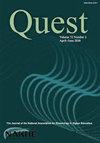运动科学本科学生的规范体能:如何比较?
IF 1.7
3区 教育学
Q2 EDUCATION & EDUCATIONAL RESEARCH
引用次数: 2
摘要
摘要:本研究的目的是报告运动科学本科学生的规范体质数据,并将结果与美国运动医学学院(ACSM)公布的标准进行比较。514名参与者(男性,n = 204;年龄在18 - 29岁的女性共310例。评估运动前心率和血压、体重指数、腰围、皮肤褶厚度以估计全身脂肪百分比(BF%)、估计最大摄氧量(VO2max)和肌肉耐力。计算百分位数并与ACSM的百分位数进行比较,并对中位数进行假设检验。男学生的中位数BF%比标准标准更低(p < 0.001)。两种性别的VO2max均低于公布的中位数(p < 0.001)。学生们的表现与acsm公布的肌肉耐力评估相当。运动科学专业的学生并不比ACSM公布的规范数据更健康。本文章由计算机程序翻译,如有差异,请以英文原文为准。
Normative Fitness in Undergraduate Exercise Science Students: How Do They Compare?
ABSTRACT The purpose of this study was to report normative physical fitness data for Exercise Science undergraduate students and compare the findings with criteria published by the American College of Sports Medicine (ACSM). 514 participants (males, n = 204; females, n = 310) aged from 18 to 29 years participated in this descriptive study. Pre-exercise heart rate and blood pressure, body mass index, waist circumference, skinfold thicknesses to estimate total body fat percentage (BF%), estimated maximal oxygen intake (VO2max), and muscular endurance were evaluated. Percentiles were calculated and compared to those from the ACSM, with hypothesis testing of the medians. The median BF% for male students was leaner (p < 0.001) than criterion standards. VO2max was lower compared to the published median in both sexes (p < 0.001). Students performed on par with ACSM-published muscular endurance assessments. Exercise Science students are not fitter than the normative data published by the ACSM.
求助全文
通过发布文献求助,成功后即可免费获取论文全文。
去求助
来源期刊

Quest
社会科学-运动科学
CiteScore
4.50
自引率
14.30%
发文量
16
期刊介绍:
Quest is the official journal of the National Association for Kinesiology in Higher Education (NAKHE). It is the leading journal for interdisciplinary scholarship for professionals in kinesiology in higher education. Quest provides a public forum for scholarship, creative thought, and research relevant to a broad range of interests held by faculty and leaders in higher education today.
Quest publishes: 1) manuscripts that address issues and concerns relevant and meaningful to the field of kinesiology; 2) original research reports that address empirical questions that are contextualized within higher education and hold significance to a broad range of faculty and administrators in kinesiology; and 3) reviews of literature and/or research of interest to one or more sub-disciplines in kinesiology. Quest does not publish papers focused on sport (e.g., amateur, collegiate, professional) that are contextualized outside of kinesiology in higher education.
 求助内容:
求助内容: 应助结果提醒方式:
应助结果提醒方式:


